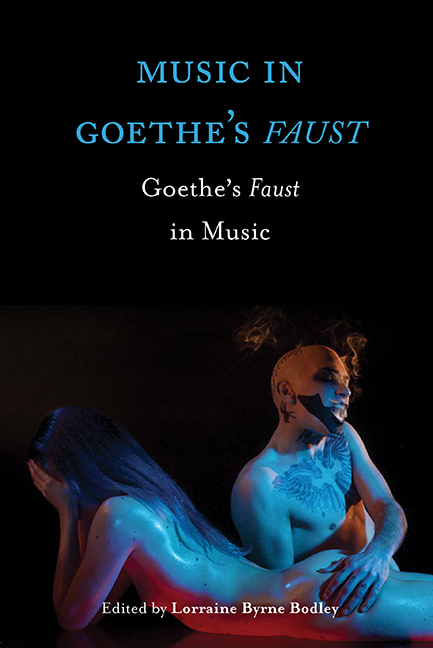Book contents
- Frontmatter
- Dedication
- Contents
- List of Illustrations
- Contributors
- Acknowledgements
- Abbreviations Used in the Notes
- Introduction. Rhapsody and Rebuke: Goethe's Faust in Music
- Part I Goethe's Faust: Content and Context
- Part II Legacies: Goethe's Faust in the Nineteenth Century
- 6 Faust's Schubert: Schubert's Faust
- 7 The Musical Novel as Master-genre: Schumann's Szenen aus Goethes Faust
- 8 The Psychology of Schumann's Faust: Developing the Human Soul
- 9 A Life with Goethe: Wagner's Engagement with Faust in Music and in Words
- 10 Wagner's Ninth: Reading Beethoven with Faust
- 11 Linking Christian and Faustian Utopias: Mahler's Setting of the Schlußszene in his Eighth Symphony
- Part III Topographies: Stagings and Critical Reception
- Part IV New Directions: Recent Productions and Appropriations
- Select Bibliography
- Index
9 - A Life with Goethe: Wagner's Engagement with Faust in Music and in Words
from Part II - Legacies: Goethe's Faust in the Nineteenth Century
Published online by Cambridge University Press: 30 August 2017
- Frontmatter
- Dedication
- Contents
- List of Illustrations
- Contributors
- Acknowledgements
- Abbreviations Used in the Notes
- Introduction. Rhapsody and Rebuke: Goethe's Faust in Music
- Part I Goethe's Faust: Content and Context
- Part II Legacies: Goethe's Faust in the Nineteenth Century
- 6 Faust's Schubert: Schubert's Faust
- 7 The Musical Novel as Master-genre: Schumann's Szenen aus Goethes Faust
- 8 The Psychology of Schumann's Faust: Developing the Human Soul
- 9 A Life with Goethe: Wagner's Engagement with Faust in Music and in Words
- 10 Wagner's Ninth: Reading Beethoven with Faust
- 11 Linking Christian and Faustian Utopias: Mahler's Setting of the Schlußszene in his Eighth Symphony
- Part III Topographies: Stagings and Critical Reception
- Part IV New Directions: Recent Productions and Appropriations
- Select Bibliography
- Index
Summary
Goethe's Faust was profoundly important for Richard Wagner. He knew of it as a young boy and read it as a teenager; he composed songs, ‘Seven Compositions on Goethe's Faust’ (1829–30), probably in conjunction with the appearance of his sister, Rosalie, as Gretchen, in the first Leipzig production. Wagner suppressed these student works; they were first published posthumously. Unlike numerous contemporaries, Wagner never attempted an operatic or oratorical setting of the play; his single mature work on Faust, A Faust Overture, is seldom performed. Its composition and early reception, however, bear witness to its significance for Wagner as work and as subject matter. Its reception history documents its contribution to the development of programmatic orchestral music and the midcentury debates about it, and its place in the critical discourse on the play. And the many commentaries by Wagner on Faust and Goethe express his continuing, not uncritical fascination with the play and its author.
The Faust Overture: ‘Urfaust’ (1840) and Revision (1855)
Wagner composed a symphonic movement in d minor in December 1839 to January 1840 in Paris, as the first movement of a planned ‘Faust’ Symphony. He sketched a ‘Gretchen’ theme (manuscript entry) for a second movement, but then abandoned the idea of a symphony, writing to Meyerbeer of an ‘Ouvertüre, Faust, erster Teil’. With Meyerbeer's help a performance was arranged in February 1841, but Wagner decided instead on an earlier work, the overture ‘Columbus’. Wagner's hope for a rehearsal performance by the Paris Conservatory Orchestra was not realized.
The movement is in sonata form, with a weighty slow introduction and an extensive coda. The introduction begins by stating a rhetorically weighty rhythmic-melodic ‘Grundgestalt’ (bars 1–5) that underlies the initial ideas of both thematic-tonal groups in the sonata movement (bars 34ff and 120ff, respectively) and frequently appears in thematic extensions and developmental sections. Moreover, the incipits of these themes are first stated in the introduction (bars 10–12 and 21–23 respectively), which presents several other important motivicrhythmic ideas (e.g. the sixteenth-note groups first heard in bar 5).
- Type
- Chapter
- Information
- Music in Goethe's FaustGoethe's Faust in Music, pp. 155 - 171Publisher: Boydell & BrewerPrint publication year: 2017



